By Michael M. Dugan
Preplanning pays off! Every department, every firehouse, and every company has one: a building that you dread hearing the tone drop for, the address that scares you and all of the members of your unit. These buildings are in every district and in every town. What makes one operation at these buildings go like clockwork and another one take a bad turn? The answers are preplanning and prefire knowledge. Companies and departments that drill at these buildings usually have a better and safer firefight and fewer issues during a fire.
 |
| (1) Firefighters have a line in place and are ready to advance into an adjoining store as the primary line is preparing to operate in the rear. (Photos 1 and 2 by Anthony Guerne. |
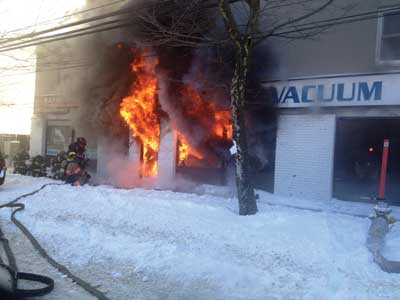 |
| (2) The front store windows have been taken on orders of the IC because the line in the rear of the building is beginning to make a push on the fire from the rear as per the preplan of this building. |
Such was the case on January 4, 2014, when the East Northport (NY) Fire Department responded at 1454 hours to a report of fire in a building with stores and a single apartment on the first floor and four apartments above. Department members were familiar with the building because of numerous drills at that location. The building is of ordinary construction with wood joists and concrete block walls and a large attic above the second floor. Three separate buildings form an I-shaped building; the fire was in the front building.
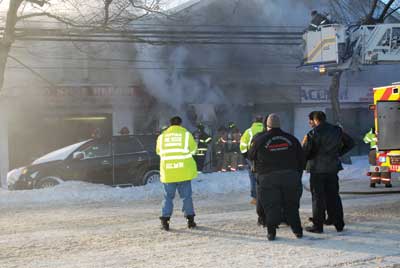 |
| (3) The truck company is being positioned to get to the roof and check for possible extension into the attic space. The tower ladder operator and member in the bucket must remain in constant communication and be aware of the overhead power lines. (Photos 3-12 by Jeff DiLavore; view the entire photo gallery here: http://fdrantnews.smugmug.com/Category/East-Northport-Fire-Department/Building-Fire-Larkfield-Road/i-Gc7r6Jz.) |
The police department arrived first on scene and confirmed a working fire with multiple residents above self-evacuating. The first-arriving engine notified dispatch of a working fire on the first floor of a two-story mixed-use building. The first-arriving chief called for immediate mutual aid, for a rapid intervention team (RIT), and for addition staffing to fight the fire and conduct searches.
 |
| (4) Members are in the adjoining store, pulling ceiling and looking for fire extension. |
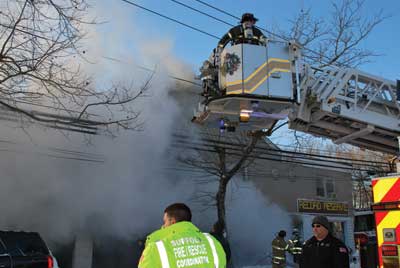 |
| (5) The truck company is being positioned for a possible deployment if fire has extended into the attic space. |
Hoselines. Members stretched the first line to the rear of the store, which is counter to what most of us would think or do unless we knew the building and had a preplan. Because of the building features, the first line went to the rear to protect the second-floor balcony, which was the primary exit and, because of building code requirements, the only exit available to the tenants. So the first line protected the primary escape route and the access to the apartments above for the member assigned to the search. This line made the initial attack through the rear of the store and pushed the fire out the front of the store. This tactic was in place because the preplan dictated that the job of the first line on a store fire was to protect the life hazard.
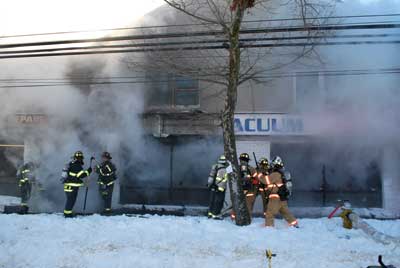 |
| (6) Members get ready to enter the fire store to do a complete secondary search. |
Members also stretched a backup to the rear to protect operating personnel and to advance up the exterior stairs to the balcony above for access to the apartment directly above the fire. Members operated a third line in the front of the building and entered the most seriously exposed store.
A large number of the tenants self-evacuated and were outside the building.
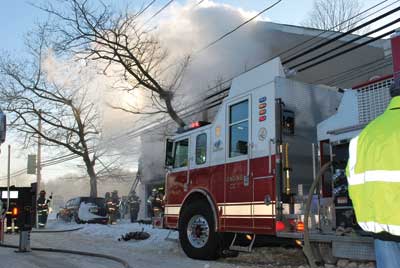 |
| (7) The weather played a part in operations at this fire. The snow, cold temperatures, and water increased the possibility of injuries. |
The fire extended to the floor above through voids in the walls, so after the initial attack, members advanced the second line to the apartment directly over the fire. This attack limited the fire extension to the apartment above; a thorough examination found no fire in the attic space.
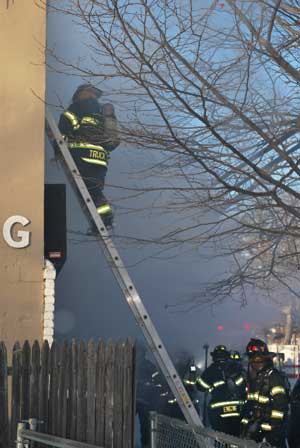 |
| (8) A member on a ladder gets ready to enter the apartment above the B side store. Another member foots the ladder, an extremely important safety measure especially in inclement weather. |
Weather. The weather at this fire caused some problems. The fire occurred right after a snowstorm, and the temperature was 15ºF at the start of the fire but dropped to 10ºF by the time units took up from the scene. Frozen hydrants and forming ice, causing a major injury hazard, were two concerns. Luckily, no injuries occurred. Another problem was after the fire all the hoselines were frozen and had to be brought back to the firehouse to thaw. In such cases, units need spare hose to replace the frozen hoselines before they can go back in service. Members have to dry and drain lines before repacking them or risk ice in the hoselines. Another issue was personnel who were standing by outside such as the RIT and emergency medical services staff; they had to be rotated because of the below-freezing temperatures.
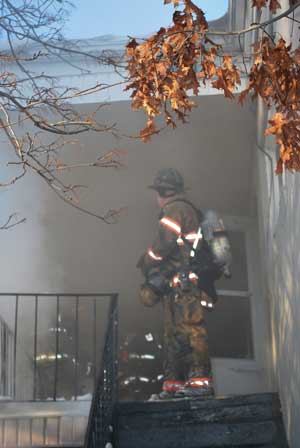 |
| (9) The rear balcony gives access to the apartments above the stores for the residents. The first hoseline was stretched to the rear because of the possibility of fleeing occupants on this balcony. |
Search. Members were challenged during the searches of this building because of the language barrier: Most of the residents spoke Spanish. Nevertheless, members were able to complete initial primary and secondary searches quickly. The incident commander (IC) asked the police department to respond with any available Spanish-speaking officers. Any firefighter on scene who spoke Spanish was heavily engaged in the firefight and not able to translate. The police sent all available bilingual officers to the scene to act as translators and interview residents about missing family members.
 |
| (10) The RIT is outside in the elements. Depending on the duration of operations, the RIT officer should consult with the IC about relief for the RIT. |
The IC also had all occupants from the fire building put in one location for a proper head count, which police conducted in a local store adjacent to the fire building. At one point early in the fire, a woman came home from work and told the IC that her children were missing. She had left them in the care of her neighbor when she left for work and was unable to contact them or the neighbor. The neighbor left her cell phone behind during the evacuation; the family was reunited after a brief search. Because of the nature of the occupancy and its residents, the IC had another unit do a third search to make sure nobody was overlooked during the initial searches.
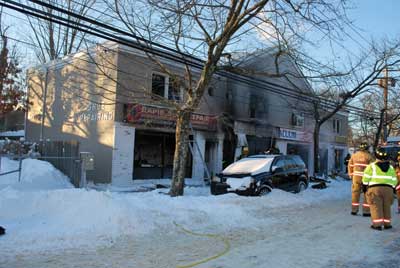 |
| (11) The front of the fire building postcontrol. Note the stores on the first floor and the apartment above. |
The cooperation between the police and the fire department was vital to the overall success of the operation in the early stages. The local Red Cross and town helped out as well. The town had buses on scene to transport all residents to a building with heat and bathrooms. The town also had trucks sand the roadway and areas around the fire building and apparatus to make it safer for member repacking hose and tools and equipment on the apparatus.
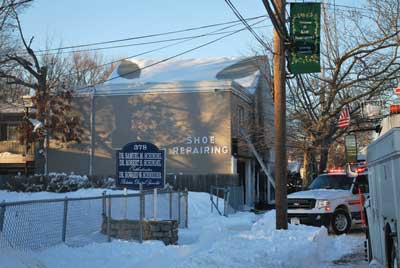 |
| (12) A side view of the building. Note the middle building behind the fire building. There are a lot of apartments in this complex, and accounting for all the occupants is tough. |
Know your district and the buildings in your response area. If you drive past a building and say, “I hope we never get a fire in that one,” you are doing yourself and your department a disservice if you’re not drilling and spending time getting to know that building.
MICHAEL M. DUGAN is a 27-year veteran of the Fire Department of New York, where he served as captain of Ladder Company 123 before retiring in 2012. As a lieutenant, he served in Ladder Company 42 and was a firefighter in Ladder Company 43. He has been involved with the fire service for 39 years.
Fire Engineering Archives

